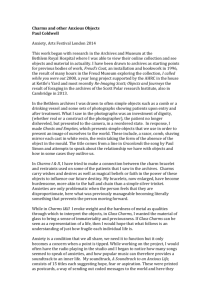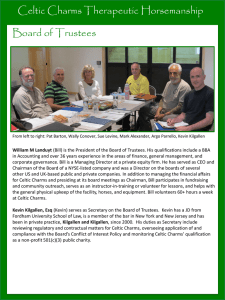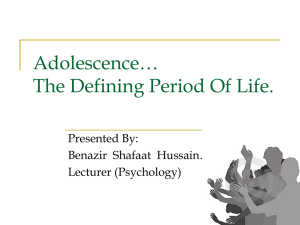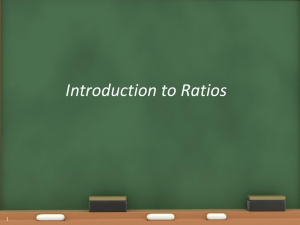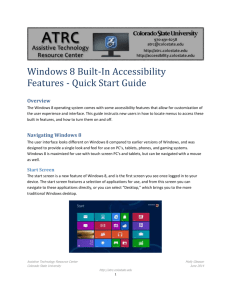USPTO Response to Comments on Annex 1 – Small Decorative
advertisement
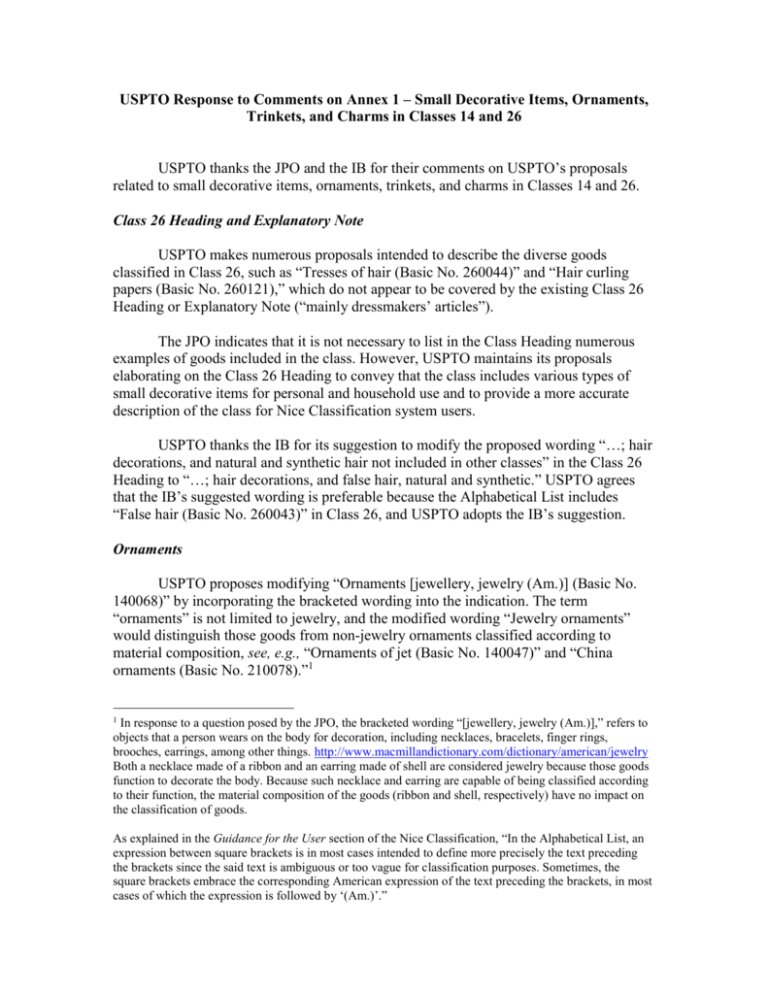
USPTO Response to Comments on Annex 1 – Small Decorative Items, Ornaments, Trinkets, and Charms in Classes 14 and 26 USPTO thanks the JPO and the IB for their comments on USPTO’s proposals related to small decorative items, ornaments, trinkets, and charms in Classes 14 and 26. Class 26 Heading and Explanatory Note USPTO makes numerous proposals intended to describe the diverse goods classified in Class 26, such as “Tresses of hair (Basic No. 260044)” and “Hair curling papers (Basic No. 260121),” which do not appear to be covered by the existing Class 26 Heading or Explanatory Note (“mainly dressmakers’ articles”). The JPO indicates that it is not necessary to list in the Class Heading numerous examples of goods included in the class. However, USPTO maintains its proposals elaborating on the Class 26 Heading to convey that the class includes various types of small decorative items for personal and household use and to provide a more accurate description of the class for Nice Classification system users. USPTO thanks the IB for its suggestion to modify the proposed wording “…; hair decorations, and natural and synthetic hair not included in other classes” in the Class 26 Heading to “…; hair decorations, and false hair, natural and synthetic.” USPTO agrees that the IB’s suggested wording is preferable because the Alphabetical List includes “False hair (Basic No. 260043)” in Class 26, and USPTO adopts the IB’s suggestion. Ornaments USPTO proposes modifying “Ornaments [jewellery, jewelry (Am.)] (Basic No. 140068)” by incorporating the bracketed wording into the indication. The term “ornaments” is not limited to jewelry, and the modified wording “Jewelry ornaments” would distinguish those goods from non-jewelry ornaments classified according to material composition, see, e.g., “Ornaments of jet (Basic No. 140047)” and “China ornaments (Basic No. 210078).”1 In response to a question posed by the JPO, the bracketed wording “[jewellery, jewelry (Am.)],” refers to objects that a person wears on the body for decoration, including necklaces, bracelets, finger rings, brooches, earrings, among other things. http://www.macmillandictionary.com/dictionary/american/jewelry Both a necklace made of a ribbon and an earring made of shell are considered jewelry because those goods function to decorate the body. Because such necklace and earring are capable of being classified according to their function, the material composition of the goods (ribbon and shell, respectively) have no impact on the classification of goods. 1 As explained in the Guidance for the User section of the Nice Classification, “In the Alphabetical List, an expression between square brackets is in most cases intended to define more precisely the text preceding the brackets since the said text is ambiguous or too vague for classification purposes. Sometimes, the square brackets embrace the corresponding American expression of the text preceding the brackets, in most cases of which the expression is followed by ‘(Am.)’.” USPTO thanks the IB for its suggestion to delete “Ornaments [jewellery, jewelry (Am.)]” from the Alphabetical List. USPTO agrees with the IB’s suggestion to delete this indication because the term “ornaments” is too broad and because the goods intended to be covered by Basic No. 140068 are already covered by “Jewelry (Basic No. 140050)”. Furthermore, deleting the term would simplify the classification of “ornaments.” If Basic No. 140068 is deleted, then NCL 10-2014 requires classification of all “ornaments” according to material composition consistent with Basic Nos. 140047 and 210078. USPTO withdraws its proposal to modify Basic No. 140068 and, instead, proposes to delete Basic No. 140068, as suggested by the IB. Trinkets USPTO thanks the IB for its suggestion to delete “Trinkets [jewellery, jewelry (Am.)]” from Basic No. 140018 because the term is overbroad. USPTO agrees and withdraws its previous proposals to modify “Trinkets [jewellery, jewelry (Am.)]” and to add “Trinkets other than for jewellery/jewelry” in Class 26. USPTO instead proposes to delete “Trinkets [jewellery, jewelry (Am.),” as suggested by the IB. Charms USPTO proposes to clarify the term “Charms [Jewellery/jewelry (Am.)] (Basic No. 140018)” by changing it to “Jewellery/jewelry charms” and adding “Charms for jewelry” in Class 14. USPTO also proposes adding “Charms other than for jewelry” in Class 26 to limit the classification of these small decorative items to Classes 14 and 26. “Jewellery/jewelry charms” and “Charms for jewelry” refer to the same types of goods and should both appear under Basic No. 140018. The IB indicates that its current practice is to classify all “charms,” whether “charms for jewelry” or “charms other than for jewelry” in Class 14.2 The JPO, on the other hand, believes that “charms other than for jewelry” is overbroad and include goods in Classes 9, 14, 28, and others. The disagreement with USPTO’s proposal and the conflicting comments from the IB and the JPO suggests an inconsistent classification practice among national offices and between the national offices and the IB. This inconsistent classification practice underscores the need for a clear framework for classifying small decorative items, such as charms that attach to objects rather than to jewelry. USPTO is amenable to adopting a classification principle requiring classification of all “charms” in a single class (Class 14) because such a practice would be easiest to administer. However, a strict requirement to classify all “charms” in Class 14 would result in the classification of a wide variety of dissimilar, jewelry and non-jewelry items in Class 14, including bracelet charms, eyeglasses charms, beverage glassware charms, cell phone charms, and pencil charms, shown below. According to the Madrid Goods and Services Manager, the IB classifies “bracelet charms” and “decorative charms for cellular phones” in Class 14. However, the IB classifies “charms for attachment to beverage glassware” in Class 21. 2 On the other hand, USPTO’s proposals limit the types of charms in Class 14 to “Jewelry charms” or “Charms for jewelry” and require classification of all other non-jewelry charms, such as eyeglass charms, beverage glassware charms, cell phone charms, and pencil charms, in a single class (Class 26) as “small items intended to decorate or adorn clothing, footwear, headgear, travelling bags, or household objects...,” or “Charms other than for jewelry.” Both the IB and the JPO are concerned that the wording “Charms other than for jewelry” is vague and overbroad. However, this wording is intended to capture all types of small decorative items for personal and household use which may currently be classified in various classes according to the items that they adorn, or classified according to material composition, depending on a particular national office’s domestic policy, and consolidate them into a single class. To prepare for further discussion at the 24th Session of the Committee of Experts, USPTO poses the following questions to the Committee: 1. What is your national office’s general practice for classifying small decorative items for personal and household use, such as eyeglass charms, beverage glassware charms, cell phone charms, and pencil charms? For example, do you generally classify these goods according to the items that they adorn, or do you generally classify them according to material composition? 2. Do you generally favor classifying all “charms” for personal and household use in a single class (Class 14) because those charms, such as eyeglasses charms, beverage glassware charms, cell phone charms, and pencil charms, are comparable to jewelry charms? If so, would you apply this classification principle to other small items intended to decorate or adorn clothing, footwear, headgear, travelling bags or household objects? 3. Or, as an alternative, do you favor limiting the types of charms in Class 14 to jewelry charms, and classifying other types of “charms” in Class 26 under the proposed wording in the Class 26 Explanatory Note (“Class 26 includes…small items intended to decorate or adorn clothing, footwear, headgear, travelling bags or household objects, not included in other classes”) and the proposed new indication “Charms other than for jewelry” in Class 26? USPTO again thanks the Committee for considering these issues and looks forward to the discussion at the 24th Session of the Committee of Experts.

